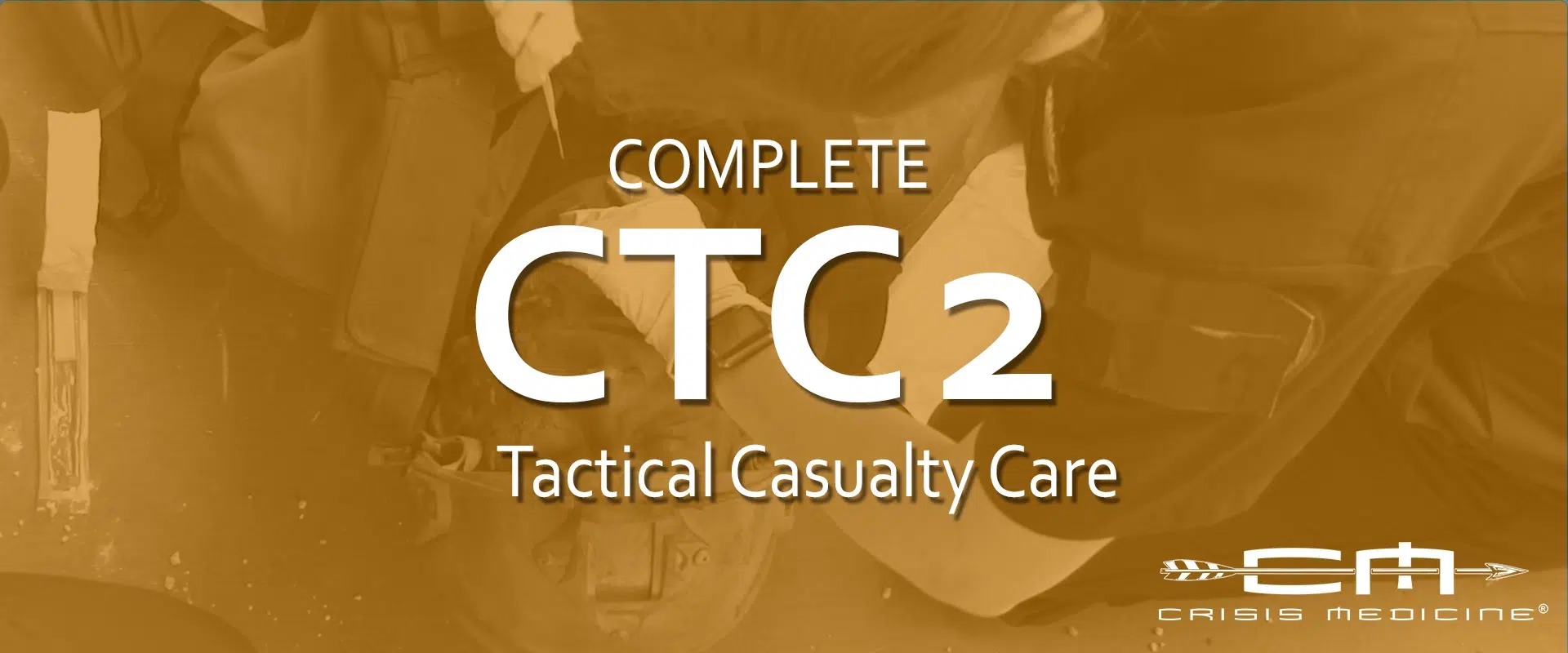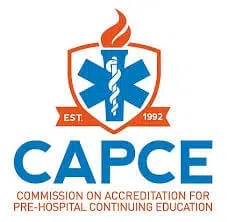Complete Tactical Casualty Care Course
This dynamic and practical course covers the complete evaluation and treatment of the tactical casualty during both the Care Under Fire/Direct Threat, Tactical Field Care/Indirect Threat phases, and solid preparation of the casualty for the evacuation phase to increase survivability.
Online, self-paced. Every aspect of the course was reviewed and revised in June, 2025.
This course was designed for the pre-hospital provider or dedicated medic in mind. Skills taught in this course include higher level, paramedic level skills and others may find some taught skills are beyond their scope of practice. Many students have attended with no prior medical knowledge or training, but the course is designed for a student with at least an Emergency Medical Responder background. This course is ideal for the tactical medic, whether in support of military operations, SOF, or tactical law enforcement operations.
This stand-alone course covers all the materials presented in the Advanced Tactical Casualty Care course and builds upon those skills with more detailed airway interventions, surgical airways, intraosseous (and to a lesser extent intravenous) access, fluid resuscitation, TCCC/TECC relevant medications, as well as dedicated litters.
The course uses photographs of actual injuries, diagrams of wounds, and step-by-step demonstrations. The material is presented in an easy to understand, directly applicable way. This class is consistent with current Tactical Combat Casualty Care Guidelines for Medical Providers as well as the Guidelines for Tactical Emergency Casualty Care. If topics are presented in the TCCC or TECC guidelines, they’re presented in this course.
CAPCE accredited CEH awarded upon successful completion.
Want to see an example of the course?
You can see the teaching lecture and skills station for the Foley Catheter Wound Packing technique. This material is excerpted from the Junctional Hemorrhage and Hemostatic lecture and skills stations.
The Complete TC2 course covers everything in the Advanced TC2:
The nature and myths of gunshot wounds and realities of their medical management
How to rapidly evaluate injuries and how they affect your tactical treatment plan
The concept of “care under fire” and how it differs from a non-tactical medical situation
Choosing appropriate medical care for each treatment phase
Assessment and management of penetrating, blunt, and blast injuriesAssessment and management of massive hemorrhage including extensive practical exercises managing all types of hemorrhage, including junctional hemorrhage, effectively packing wounds, and hemostatic agents
The safe and efficient use of improvised and commercially available tourniquets
Basic airway and breathing assessment, as well as management within a high risk environment
Nasal pharyngeal airways and airway positioning
In-depth discussion of thoracic trauma (chest injuries), chest seals, recognition of tension pneumothorax and its decompression
Appropriate treatment of casualties with abdominal injuries or head injuries
Casualty hypothermia prevention
Techniques for moving casualties to a safer location, with detailed training and practice moving casualties efficiently
Triage of multiple casualties and setting up a Casualty Collection Point
Tactical casualty care concepts and their application
And the Complete TC2 Course adds the following topics and skills:
Airway management using nasal pharyngeal airways, airway positioning and surgical airways
Appropriate treatment of casualties with ocular injuries, as well as burns, fractures, and mine injuries
The reality of fluid resuscitation
Intraosseous access, and to a lesser extent intravenous access of the casualty
Using the Hypothermia Prevention and Management Kit (HPMK) and the Blizzard Bag
Proper litter use, including Skedco, Talon, non-rigid, and improvised
Students receive a certificate at the course conclusion indicating they have taken a course based on the TECC/TCCC guidelines. Students who provide State or National registry information will be provided a CAPCE compliant certificate for CEH.
Students have 9 months from purchase date to complete the course.
No prior medical knowledge or training is necessary to take this course, but it teaches some skills your state may characterize as paramedic level.
CAPCE Accredited Provider
This CE activity is accredited for 27 Advanced CEH by Crisis Medicine, an organization accredited by the Commission on Accreditation for Prehospital Continuing Education.
ASIS Preferred CPE Provider
This program is accredited for 27 CPEs and can be used for recertification for APP, CPP, and/or PSP designations.
Still not sure? Take a look at our Students’ Experience with CTC2
Course Features
- Lectures 119
- Quizzes 10
- Duration 27 Hours
- Skill level All levels
- Students 702
- Certificate Yes
- Assessments Yes
- 10 Sections
- 119 Lessons
- 40 Weeks
- Foundational Understanding11
- 1.1Course Orientation – CTC22 Minutes
- 1.2Always Updated2 Minutes
- 1.3Introduction to Crisis Medicine – CTC210 Minutes
- 1.4Complete Tactical Casualty Care Workbook **DOWNLOADABLE PDF**
- 1.5Introduction to Complete Tactical Casualty Care – CTC2 Part 119 Minutes
- 1.6Introduction to Complete Tactical Casualty Care – CTC2 Part 223 Minutes
- 1.7Quiz: Introduction CTC212 Minutes12 Questions
- 1.8Wound Ballistics and Combat Mindset – CTC2 Part 123 Minutes
- 1.9Wound Ballistics – CTC2 Part 225 Minutes
- 1.10Wound Ballistics – CTC2 Part 328 Minutes
- 1.11Wound Ballistics Quiz (CTC2)6 Minutes6 Questions
- Bleeding Management36
- 2.1Hemorrhage Control Concepts – CTC2 part 119 Minutes
- 2.2Hemorrhage Control Concepts – CTC2 Part 221 Minutes
- 2.3Skills: Direct Pressure – CTC21 Minute
- 2.4Skills: Bandaging – CTC217 Minutes
- 2.5Quiz: Hemorrhage Control Concepts & Skills CTC215 Minutes15 Questions
- 2.6Tourniquet Concepts – CTC215 Minutes
- 2.7Co-TCCC Tourniquets – CTC27 Minutes
- 2.8Proper / Improper Tourniquet Application CTC218 Minutes
- 2.9Tourniquets: Removal / Conversion10 Minutes
- 2.10Tourniquets on Actual Casualties – CTC218 Minutes
- 2.11Tourniquets & Pediatrics – CTC24 Minutes
- 2.12Tourniquet Breakage – CTC27 Minutes
- 2.13Counterfeit Tourniquets – CTC27 Minutes
- 2.14Skills: CAT Tourniquets Gen 6 & 7 – CTC225 Minutes
- 2.15Skills: CAT Casualty Application – CTC26 Minutes
- 2.16Skills: SOF Tourniquets – CTC213 Minutes
- 2.17Skills: SAM XT Tourniquet – CTC25 Minutes
- 2.18Skills: RMT Tourniquet – CTC26 Minutes
- 2.19Skills: TMT Tourniquet – CTC23 Minutes
- 2.20Skills: Improvised Tourniquets – Military TQT Cravat & Windlass – CTC26 Minutes
- 2.21Quiz: Tourniquets – CTC210 Minutes10 Questions
- 2.22Scenario: A Bad Day At the Office – CTC24 Minutes
- 2.23Junctional Hemorrhage – CTC216 Minutes
- 2.24Hemostatics – CTC230 Minutes
- 2.25Skills: Wound Packing – CTC25 Minutes
- 2.26Skills: Hemostatic Agents – CTC210 Minutes
- 2.27XSTAT – CTC221 Minutes
- 2.28iT Clamp – CTC213 Minutes
- 2.29Wound Packing with Foley Catheter – CTC27 Minutes
- 2.30Skills: Wound Packing Bandage – CTC29 Minutes
- 2.31Junctional Tourniquets & DCBI: Dismounted Complex Blast Injury – CTC210 Minutes
- 2.32Quiz: Junctional Hemorrhage & Hemostatic Agents – CTC26 Minutes6 Questions
- 2.33Scenario: Tough Day in the Ladies’ Room – CTC22 Minutes
- 2.34Skills: Blood Sweep & Casualty Evaluation – CTC210 Minutes
- 2.35Case: Forearm Versus Plate Glass Window – CTC29 Minutes
- 2.36Scenario: Worst Place to Work – CTC22 Minutes
- Airway11
- 3.1Airway – CTC223 Minutes
- 3.2Skills: Head Tilt, Chin Lift – CTC22 Minutes
- 3.3Skills: Nasopharyngeal Airway – CTC23 Minutes
- 3.4Quiz: Airway – CTC24 Minutes4 Questions
- 3.5i-Gel Supraglottic Airway – CTC223 Minutes
- 3.6Surgical Airways – Part 1 – CTC218 Minutes
- 3.7Surgical Airways – Part 2 – CTC218 Minutes
- 3.8Surgical Airways – Part 3 – CTC29 Minutes
- 3.9Skills: Surgical Airways – CTC239 Minutes
- 3.10Securing Surgical Airways – CTC25 Minutes
- 3.11Surgical Airways5 Minutes2 Questions
- Respiration10
- 4.1Thoracic Trauma – CTC226 Minutes
- 4.2Tension Pneumothorax – CTC217 Minutes
- 4.3Chest Seals20 Minutes
- 4.4Skills: Chest Seals – CTC215 Minutes
- 4.5Needle Decompression -Introduction – CTC211 Minutes
- 4.6Needle Decompression – Procedure – CTC212 Minutes
- 4.7Needle Decompression – Finesse points – CTC227 Minutes
- 4.8Skills: Needle Decompression – CTC214 Minutes
- 4.9Finger Thoracostomy – CTC213 Minutes
- 4.10Skills: Finger Thoracostomy – CTC28 Minutes
- Circulation17
- 5.1Blood, Blood Components & IVF21 Minutes
- 5.2Hypotensive Resuscitation – CTC219 Minutes
- 5.3Intravenous Access- CTC214 Minutes
- 5.4Skills: IV Access – CTC210 Minutes
- 5.5Intraosseous Access – CTC219 Minutes
- 5.6IO: FAST111 Minutes
- 5.7IO: NIO7 Minutes
- 5.8IO: EZ IO15 Minutes
- 5.9IO: Sam Manual4 Minutes
- 5.10IO:Talon2 Minutes
- 5.11IO Conclusions14 Minutes
- 5.12Skills: IO FAST1, NIO, EZIO – CTC213 Minutes
- 5.13Skills: IO SAM Manual6 Minutes
- 5.14Skills: IO Talon3 Minutes
- 5.15Fluid Warmers CTC26 Minutes
- 5.16Calcium Administration6 Minutes
- 5.17Quiz: IV Access & Fluid Resuscitation5 Minutes4 Questions
- Movement7
- Other Injuries15
- 7.1Head Injuries – CTC232 Minutes
- 7.2Ocular Injuries – CTC215 Minutes
- 7.3Skills: Fox Eye Shield – CTC21 Minute
- 7.4Abdominal Injuries – CTC221 Minutes
- 7.5Skills: Abdominal Injuries – Evisceration7 Minutes
- 7.6Case: Pulse Nightclub – CTC26 Minutes
- 7.7Fractures – CTC232 Minutes
- 7.8Pelvic Fractures11 Minutes
- 7.9Quiz: Fractures6 Minutes4 Questions
- 7.10Blast Injuries – CTC220 Minutes
- 7.11Burns – CTC221 Minutes
- 7.12Mine Injuries – CTC213 Minutes
- 7.13Case: Cambodian Farmer Mine Injury – CTC24 Minutes
- 7.14Skills: Stump Dressing – CTC24 Minutes
- 7.15Scenario: Rule #4 – CTC23 Minutes
- Conclusion & Implementation12
- 8.1Phases of Tactical Casualty Care – CTC225 Minutes
- 8.2Traumatic Out of Hospital Cardiac Arrest– CTC211 Minutes
- 8.3Evaluation of Hypovolemic Shock – CTC216 Minutes
- 8.4Medications: Pain – CTC223 Minutes
- 8.5Medications: Antibiotics – CTC213 Minutes
- 8.6Monitoring – CTC210 Minutes
- 8.7Monitoring Skills – CTC24 Minutes
- 8.8Final Points – CTC224 Minutes
- 8.9Public Access Hemorrhage Control Kits – CTC26 Minutes
- 8.10Triage – CTC231 Minutes
- 8.11Quiz: Phases of Tactical Casualty Care- CTC222 Minutes22 Questions
- 8.12Case: Virginia Tech – CTC28 Minutes
- Scenarios8
- 9.1Scenario: A Breach Gone Bad – CTC23 Minutes
- 9.2Scenario: Mind Your Manners When driving – CTC26 Minutes
- 9.3Scenario: Improvised Tourniquet Conversion – CTC23 Minutes
- 9.4Scenario: Shot on Entry – CTC23 Minutes
- 9.5Scenario: Shot Through the Wall – CTC28 Minutes
- 9.6Scenario: You Don’t Always Get Trained Help CTC23 Minutes
- 9.7Scenario: Suspicious Package – CTC28 Minutes
- 9.8Scenario: Drag Him to Me – CTC215 Minutes
- Student Evaluation & Certification of Hours of Instruction2



